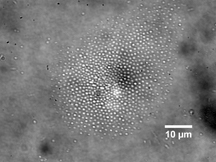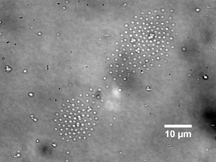New biochip technology uses tiny whirlpools to corral microbes
January 8, 2013
 |
|
Researchers
have demonstrated a new technology that combines a laser and electric fields to
create tiny centrifuge-like whirlpools to separate particles and microbes by
size, a potential lab-on-a-chip system for medicine and research. Here the
technique is used to collect a bacterium called Shewanella oneidensis. (Purdue University image)
|
WEST LAFAYETTE, Ind. - Researchers have demonstrated a new technology that combines a laser and electric fields to create tiny centrifuge-like whirlpools to separate particles and microbes by size, a potential lab-on-a-chip system for medicine and research.
The theory behind the technology, called rapid electrokinetic patterning - or REP - has been described in technical papers published between 2008 and 2011. Now the researchers have used the method for the first time to collect microscopic bacteria and fungi, said Steven T. Wereley, a Purdue University professor of mechanical engineering.
The technology could bring innovative sensors and analytical devices for lab-on-a-chip applications, or miniature instruments that perform measurements normally requiring large laboratory equipment. REP is a potential new tool for applications including medical diagnostics; testing food, water and contaminated soil; isolating DNA for gene sequencing; crime-scene forensics; and pharmaceutical manufacturing.
"The new results demonstrate that REP can be used to sort biological particles but also that the technique is a powerful tool for development of a high-performance on-chip bioassay system," Wereley said.
A research paper about the technology was featured on the cover of the Dec. 7 issue of Lab on a Chip magazine, and the work is highlighted as a news item in the Jan. 13 issue of Nature Photonics, posted online Dec. 27. Mechanical engineering doctoral student Jae-Sung Kwon, working extensively with Sandeep Ravindranath, a doctoral student in agricultural and biological engineering, was lead author of the Lab on a Chip paper.
The technology works by using a highly focused infrared laser to heat fluid in a microchannel containing particles or bacteria. An electric field is applied, combining with the laser's heating action to circulate the fluid in a "microfluidic vortex," whirling mini-maelstroms one-tenth the width of a human hair that work like a centrifuge to isolate specific types of particles based on size.
 |
|
Here
the rapid electrokinetic patterning technique is used to arrange bacteria into
a specific pattern. The technique may be used as a tool for nanomanufacturing
because it shows promise for the assembly of suspended particles, called
colloids. The ability to construct objects with colloids makes it possible to
create structures with particular mechanical and thermal characteristics to
manufacture electronic devices and tiny mechanical parts. (Purdue University
image)
|
Particles of different sizes can be isolated by changing the electrical frequency, and the vortex moves wherever the laser is pointed, representing a method for positioning specific types of particles for detection and analysis.
The Lab on a Chip paper was written by Kwon; Ravindranath; Aloke Kumar, a researcher at the Oak Ridge National Laboratory; Joseph Irudayaraj, a Purdue professor of agricultural and biological engineering and deputy director of the Bindley Bioscience Center; and Wereley.
Much of the research has been based at the Birck Nanotechnology Center in Purdue's Discovery Park, in collaboration with Irudayaraj's group in the Bindley Bioscience Center.
The researchers used REP to collect three types of microorganisms: a bacterium called Shewanella oneidensis MR-1; Saccharomyces cerevisiae, a single-cell spherical fungus; and Staphylococcus aureus, a spherical bacterium. The new findings demonstrate the tool's ability to perform size-based separation of microorganisms, Wereley said.
"By properly choosing the electrical frequency we can separate blood components, such as platelets," he said. "Say you want to collect Shewanella bacteria, so you use a certain electrical frequency and collect them. Then the next day you want to collect platelets from blood. That's going to be a different frequency. We foresee the ability to dynamically select what you will collect, which you could not do with conventional tools."
The overall research field is called "optoelectrical microfluidics." More research is needed before the technology is ready for commercialization.
"It won't be on the market in a year," Wereley said. "We are still in the research end of this. We are sort of at the stage of looking for the killer app for this technology."
REP may be used as a tool for nanomanufacturing because it shows promise for the assembly of suspended particles, called colloids. The ability to construct objects with colloids makes it possible to create structures with particular mechanical and thermal characteristics to manufacture electronic devices and tiny mechanical parts.
Purdue researchers are pursuing the technology for pharmaceutical manufacturing, Wereley said, because a number of drugs are manufactured from solid particles suspended in liquid. The particles have to be collected and separated from the liquid. This process is now done using filters and centrifuges.
REP also might be used to diagnose the presence of viruses, as well, although it has not yet been used to separate viruses from a sample, Wereley said.
Unlike conventional tools, REP requires only tiny samples, making it potentially practical for medical diagnostics and laboratory analysis.
Writer: Emil Venere, 765-494-4709, venere@purdue.edu
Sources: Steven T. Wereley, 765-494-5624, wereley@purdue.edu
Joseph Irudayaraj, 765-494-0388, josephi@purdue.edu
Aloke Kumar, 865-574-8661, alokek@gmail.com
Related web site:
Lab on a Chip on Twitter
Note to Journalists: An electronic copy of the research paper is available from the journal or by contacting Emi Venere, Purdue News Service, at 765-494-4709, venere@purdue.edu
ABSTRACT
Opto-Electrokinetic Manipulation for High-Performance On-Chip Bioassays
Jae-Sung Kwon,a Sandeep P. Ravindranath,b Aloke Kumar,c Joseph Irudayarajb and Steven T. Wereley*a
aSchool of Mechanical Engineering and Birck Nanotechnology Center, Purdue University
bSchool of Agricultural and Biological Engineering and Bindley Bioscience Center, Purdue University
cBiosciences Division, Oak Ridge National Laboratory
This communication first demonstrates bio-compatibility of a recently developed opto-electrokinetic manipulation technique, using microorganisms. Aggregation, patterning, translation, trapping and size-based separation of microorganisms performed with the technique firmly establishes its usefulness for development of a high-performance on-chip bioassay process. Ultimately fast and precise on-chip manipulation of microorganisms aids in development of high-performance bioassay systems.

